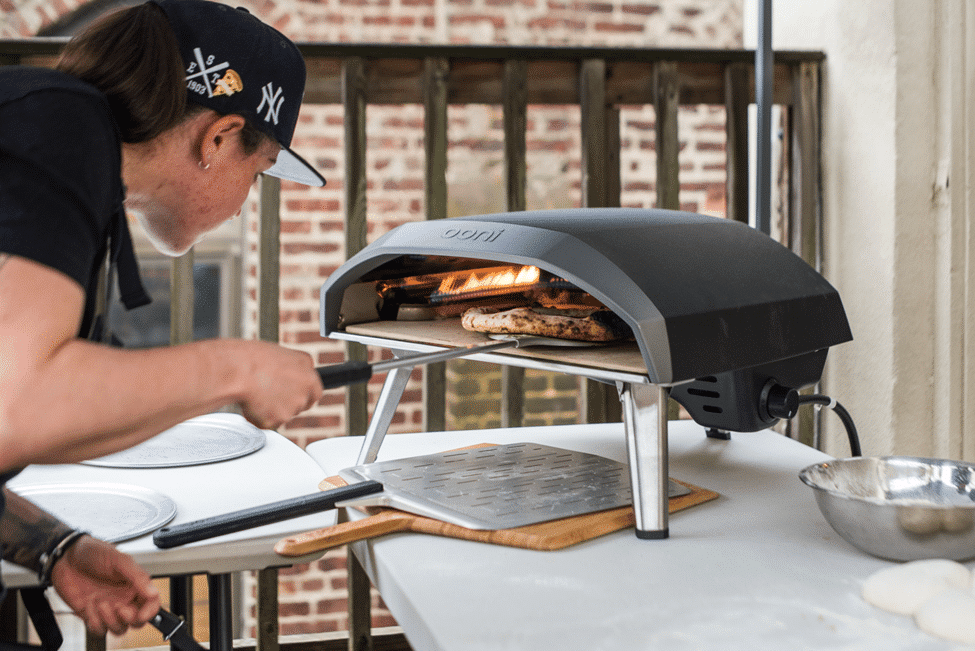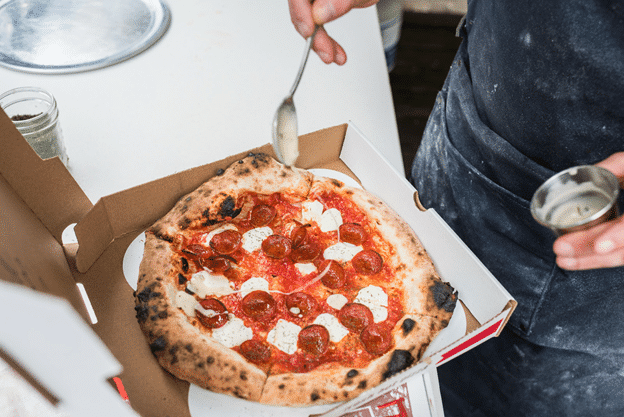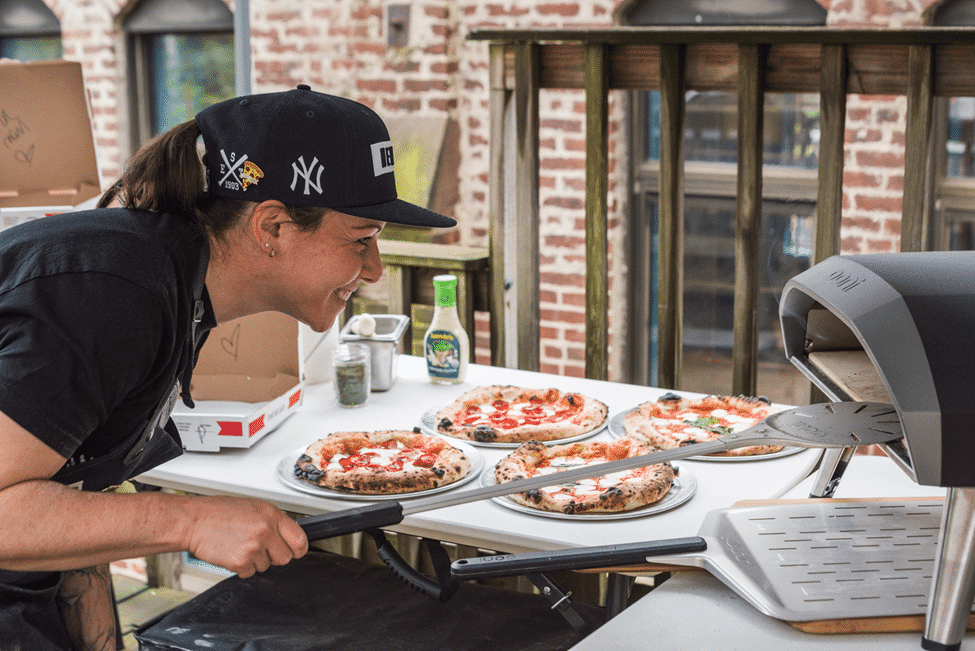
Making pizza at home has never been easier, thanks to advances in technology.
Few foods are as beloved, or widespread, as pizza. It’s everywhere, from the smallest of villages to the largest of cities, and regardless of the country or the culture, or even the continent, everyone seems to love it. Yet you’d be hard pressed to find a dish harder to make at home, because unless you’re willing to make concessions you simply cannot produce a pizzeria-quality pizza using a standard home oven.
But where you once needed a large permanently-installed custom-built outdoor oven to make quality at-home pizza, you can now purchase a small portable oven from a company like Ooni for a few hundred dollars. Thanks to that change, the next frontier for American pizza might very well be in people’s backyards and patios.

According to Mike Fadem, the chef and co-owner of the Brooklyn pizzeria Ops, “the idea of making [pizza] at home isn’t this super foreign concept.” Pizza is not a type of cooking where you need formal training, or restaurant experience, to be able to master.
While Fadem is a veteran of the restaurant industry, as a pizzaiolo (the Italian word for a pizza chef) he’s entirely self-taught, and says he learned to make pizza by watching YouTube. He drew inspiration from Joe Beddia in Philadelphia, and says, “I was inspired by the idea of not coming from a background of pizza and being able to do something unique because I wasn’t stuck in any ritual or habits that I learned from some other pizzeria.”
Fadem believes that one of the greatest problems with pizza is that it tends to be homogenous. People have prescribed ideas of what pizza should be, including how it’s topped, what it looks like, and how it should be composed. That’s one of the reasons his own pizzas are, in some ways, fairly radical. Where else will you find a pizza topped with broad slices of mortadella?
The problem is that pizza homogeneity could stem from a lot of things, including a fear that if you do something weird, people might not buy your pizza. That’s not an issue for the at-home pizza maker, where you answer only to your own palate (or, once you make even one of these pizzas for yourself, the palates of your friends, loved ones, and perhaps your neighbors). Once you’ve mastered some technical basics, such as making dough and figuring out how to best use your oven, the sky’s the limit.

Few people know this better than Miriam Weiskind, a former art director turned professional pizzaiola and educator. For eight years Weiskind worked as a tour guide for the New York-based Scott’s Pizza Tours and then at the famed pizzeria Paulie Gee’s. When the pandemic hit, her freelance work dried up, as did her gigs at Scott’s and Paulie Gee’s. To keep herself sane, and to feed her building and community, she started making pizza.
While working at Paulie Gee’s gave her professional experience, baking at home meant using her unremarkable apartment oven and a baking steel (a slab of solid metal that gets placed in an oven, where it retains and radiates heat). She says the pizza was good—and that her Sicilian pies were (and are) great—but that home ovens just don’t possess the characteristics necessary to be able to make high quality pizza.
When a PR firm offered to outfit Weiskind with a high-quality countertop pizza oven, it dramatically changed the quality of her pizza. Things got even more intense when she got an Ooni Koda 16, the model of oven that she now uses for professional pop up events. Having access to the Koda meant being able to cook for customers outdoors, building street cred and establishing a career as a pizzaiola to take seriously. Now she’s looking to start her own brick-and-mortar pizzeria, while topping pizzas in a way that pleases her own palate.

One of the pizzas Weiskind likes to highlight is the “BADA BING, BADA BANG, BADA BOOM,” a white pie she makes with bing cherries, named for the phrase she like to say when she’s excited. She’s put sugar snap peas and smoked tofu ricotta on a pizza. A combination of mozzarella, cheddar, provolone, and jalapeños have made an appearance. She’s living her best pizza life as she sees fit.
Mike Fadem thinks pizzerias can do the same as well. “We make all these creative topping pizzas with cool in season ingredients and local ingredients and all of this stuff,” he says of his own pies. The downside is that they take much longer to prep and top than a basic margarita pizza, which takes mere moments. But Fadem is impacted by the demands of running a business. If you’re making pizza just for yourself or your family, and only need to crank out a few pies instead of dozens, efficiency isn’t quite as essential.

Anthony Falco, a pizza consultant and the author of the cookbook Pizza Czar: Recipes and Know-How From a World-Traveling Pizza Chef, says “there’s a renaissance for what you can achieve at home with pizza.” That’s liberating for people who want to make pizza that’s transcendent, or for those who want to cook for their friends, but might have a limited palate.
Falco, who was raised as a vegetarian and was a picky eater as a kid, believes pizza can be equalizing. “I felt like a weirdo in my social interactions. But at a pizza party, if you’re a vegetarian you can just eat cheese pizza and you’re a normal person.”
It helps that the pizza coming out of this new breed of oven can be pretty epic. The True Neapolitan Pizza Association (Associazione Verace Pizza Napoletana, or AVPN), which acts as a regulatory body for Neapolitan-style pizzerias, recently designated Ooni’s newest oven, the Karu 16, as “Recommended for Domestic Use.” Given how persnickety the AVPN can be, that’s a big deal.
What’s so incredible about these ovens though—and their potential impact on the aspiring at-home

pizzaiolo—is that it’s just so easy. “Once you figure out how to make the pizza exactly like you want, it’s like a magic trick,” Falco says. “You’re conjuring happiness right out of the air.” And that ease combined with the ability to make pizza how you want it, means that the pizza renaissance happening across the country isn’t just limited to enterprising restaurateurs, it’s including people standing in their kitchens ordering a pizza on their phones.![]()
